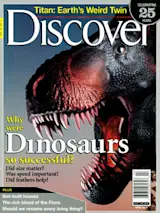As the Huygens probe prepared to plunge into the atmosphere of Titan, the scientists at the European Space Operations Center in Darmstadt, Germany, kept warning the packed auditorium full of colleagues and journalists to “expect the unexpected.” Saturn’s planet-size moon is completely enshrouded in an orange-brown haze. It is 10 times as far from the sun as Earth is, its thick atmosphere is tinged with methane (the air would burst into flame if oxygen were present), and it has about a seventh of Earth’s surface gravity. Whatever lay under Titan’s global smog would surely boggle the imagination.
On the evening of January 14, when the snapshots from Huygens started to arrive, the researchers were startled anyway. The first set of images showed formations resembling riverbeds, eroded hillsides, coastlines, sandbars, and barrier islands that made Titan look improbably like Earth. One early Huygens picture looked eerily like the New Jersey shore. ...















